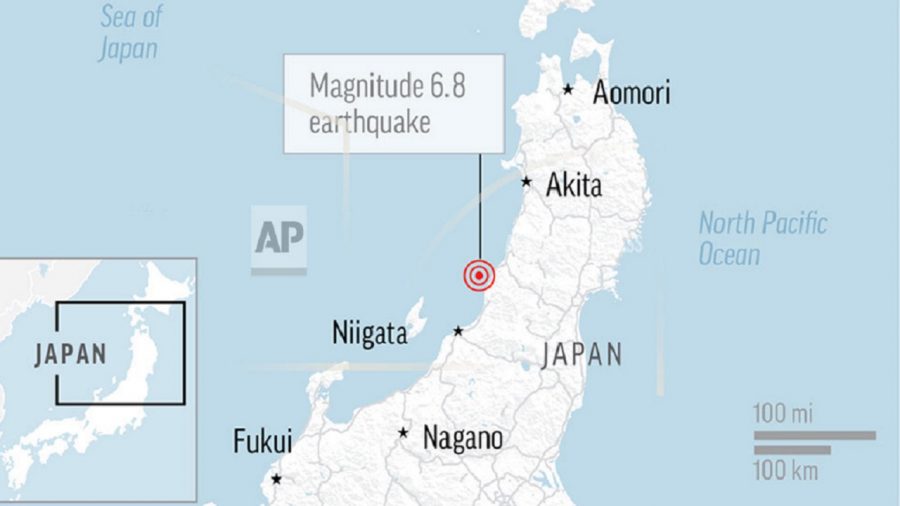TOKYO—A powerful earthquake jolted northwestern Japan late Tuesday, prompting officials to issue a tsunami warning along the coast which was lifted about 2 ½ hours later.
Thousands of families lost electrical power and bullet train services were suspended, but there were no reports of serious injuries or damage from the magnitude 6.7 quake.
The quake lasted for as long as 20 seconds and damage included a landslide that struck a road, according to public broadcaster NHK. There were no initial reports of fatalities or fires.
Authorities lifted a 0.2-1.0 meter tsunami warning for the region after waves several centimeters high struck parts of the Niigata coast.
A tsunami of up to one meter could have caused some flooding and damage in low-lying coastal areas and river banks, though much of Japan’s coastline is guarded by sea walls.
“We will work closely with local authorities to provide any disaster measures including lifesaving and rescue operations and have instructed officials to provide information in a timely and accurate manner,” Chief Cabinet Secretary Yoshihide Suga—the top government spokesman—told a media briefing.
Japan’s Meteorological Agency said the earthquake was located off the western coast of Yamagata about 50 kilometers (30 miles) southwest of the city of Sakata.
Japan’s Meteorological Agency said the quake registered a magnitude of 6.8 and was located off the western coast of Yamagata about 50km (30 miles) southwest of the city of Sakata https://t.co/toGqQ3XdKK
— The Hindu (@the_hindu) June 18, 2019
It said the quake was fairly shallow, about 14 kilometers (9 miles) below the sea’s surface. Shallow quakes tend to cause more damage.
A powerful earthquake jolted northwestern Japan on Tuesday night, and officials warned of a tsunami up to one meter (3.3 feet) high along parts of the coast. https://t.co/n2GfXRKVBu
— #NBC7 San Diego (@nbcsandiego) June 18, 2019
Chief Cabinet Secretary Yoshihide Suga said several minor injuries were reported in Niigata and Yamagata, but no serious ones. He urged residents of the affected areas to be prepared for possible aftershocks.
Tsuruoka city crisis management official Takehiko Takahashi said in a televised interview that city officials were helping coastal residents evacuate to higher ground as a precaution.
More than 1,500 people took shelter at evacuation centers in Murakami city and elsewhere in Niigata. Public broadcaster NHK showed people using flattened cardboard boxes as mattresses to sleep on in a school gym. Many others, including children, were still awake and sitting against the walls.

Bullet train service was suspended in parts of the region because of power outages and for safety checks. About 9,000 households in Yamagata and Niigata lost power, according to Tohoku Electric Power Co.
All seven reactors at the Kashiwazaki-Kariwa nuclear plant in Niigata were off line and no abnormalities were reported. Two other nuclear power plants in the affected region were also intact, according to the Nuclear Regulation Authority.
Powerful earthquake jolted northwestern Japan late Tuesday, and officials warned of a possible Tsunami up to one meter (3.3 feet) high along parts of the coast.https://t.co/tv1O1Y1bRG
— The Peninsula (@PeninsulaQatar) June 18, 2019
An emergency response team was set up at the Prime Minister’s Office to assess the extent of injuries and damage.
“We put people’s lives before anything else,” Prime Minister Shinzo Abe said. “We’ll do our utmost in rescue operations as we closely cooperate with local authorities.”
NHK showed broken glasses and dishes scattered on the floor of a bar in Tsuruoka which was empty after customers rushed out, leaving behind their half-eaten food on the counter.
Japan is one of the most earthquake- and tsunami-prone areas in the world. On March 11, 2011, a magnitude 9.0 offshore quake hit the northeast coast, causing a tsunami that took more than 18,000 lives and triggered meltdowns at the Fukushima nuclear power plant.
There was no danger of a tsunami from Tuesday’s quake on the eastern coast, where the Fukushima plant is located.
By Mari Yamaguchi. Reuters contributed to this report.

